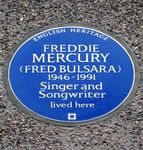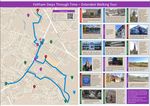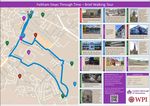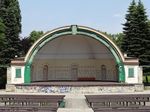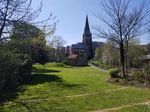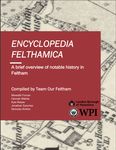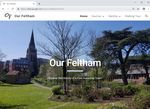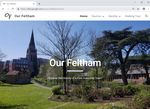Our Feltham Rediscovering the Identity of a Post-Industrial Town - Worcester Polytechnic Institute
←
→
Page content transcription
If your browser does not render page correctly, please read the page content below
London Borough of Hounslow ৷ Feltham ৷ 2019
Our Feltham
Rediscovering the Identity of a Post-Industrial Town
An Interactive Qualifying Project Report
submitted to the Faculty of the
WORCESTER POLYTECHNIC INSTITUTE
in partial fulfillment of the requirements for the
Degree of Bachelor of Science by:
Meredith Forcier ৷ BME ৷ ‘20
Hannah Mikkila ৷ ME ৷ ‘20
Kyle Reese ৷ RBE/CS ৷ ‘20
Jonathan Sanchez ৷ ME/RBE ৷ ‘20
Nicholas Wotton ৷ MA ৷ ‘20
Advisors: Professor Fabio Carrera & Professor Esther Boucher-Yip
https://sites.google.com/view/lo19-of/home
LO19.OF@gmail.com | gr-LO19-OF@wpi.edu
This report represents the work of WPI undergraduate students submitted to the faculty as evidence of completion of a degree
requirement. WPI routinely publishes these reports on its website without editorial or peer review. For more information about
the projects program at WPI, please see http://www.wpi.edu/academics/ugradstudies/project-learning.htmlAbstract
The London Borough of Hounslow is implementing a fifteen-year revitalization plan for
Feltham. Through interviews and community engagement, our project highlighted the elements
that make up the identity of the town to be incorporated in the next steps in the redesign of the
town center. The team created a website that incorporates project deliverables, a comprehensive
list of bibliographical sources, an Encyclopedia of important town assets, a walking tour of key
elements of town identity, and a promotional video.
iiAcknowledgments
There were many people who made the completion of this project possible. It has been a
long journey since we began work on the project in January 2019, but a few people have been
there all along the way to help us. Professors Fabio Carrera and Esther Boucher-Yip have been
advising us on our written work as well as presentations for the past fourteen weeks, so we
would like to thank them. We would also like to thank everyone that contributed to the project in
the first seven weeks while we were still at WPI. First, we would like to thank Professor
Creighton Peet for guiding us through the writing of the proposal. Second, we would like to
thank our research librarian, Jess O’Toole, for helping us narrow down the scope of the project
and locate sources that corresponded to that new focus. We would also like to acknowledge
Professors Robert Krueger and Suzanne Lepage for the information they provided concerning
Urban Planning in the interviews we conducted with them.
In the seven weeks we have been in England, we have had an even larger number of
contributors. First and foremost, we would like to thank our sponsor liaison, Joyce Ip. Without
her help connecting us to the community members of Feltham, we would not have been as
successful in connecting with them. We further extend our thanks to the community members of
Feltham and Hounslow that we interviewed, Richard Clarke, David Lawrie, William Horgan,
and Peter Rogers as well as the Feltham History group; James Marshall, Alan Rice, Chris Hern,
Eddie Menday, Kathy Cox, and Angela Parton, for talking to us about the wealth of history that
Feltham contains. We would also like to specifically provide our deepest gratitude to Angela
Parton for providing us with, and allowing us to use, an incredible number of pictures, both old
and newer. We would also like to thank the headteacher of Rivers Academy, Ed Vainker, for his
information on the current state of Feltham. Outside of the town of Feltham, we would like to
thank Brigitte Faubert and the Hounslow Rotary Club as well as the Feltham Rotary Club for
their feedback and communication regarding the project. Lastly, we would like to extend our
gratitude to the Borough of Hounslow employees we met with as we worked on the project,
Sofia Laird, Sean Doran, Geoffrey S. Hugall, Aine Hayes, Laura James, and Suzie Munnery.
Again, we cannot thank all of you enough for your contributions to this project. We hope
we have developed something you too can be proud of.
iiiAuthorship Table
Section Primary Author Primary Editor Primary Reviewer
Abstract Meredith All All
Acknowledgements Nicholas All All
Executive Summary Jonathan Kyle All
1 All All All
2 Nicholas Jonathan All
2.1 Kyle/Hannah Meredith All
2.1.1 Hannah Jonathan All
2.2 Nicholas Meredith All
2.2.1 Jonathan Hannah All
2.2.2 Jonathan/Meredith Kyle All
2.3 Nicholas Jonathan All
2.3.1 Hannah Jonathan All
2.4 Nicholas Jonathan All
3 Hannah Nicholas Meredith
3.1 Nicholas Jonathan Hannah
3.1.1 Jonathan Meredith Hannah
3.1.2 Nicholas Kyle Meredith
3.1.3 Meredith Nicholas Jonathan
3.2 Jonathan/Meredith Hannah Kyle
3.3 Hannah Kyle Meredith
3.3.1 Hannah Meredith Jonathan
3.3.2 Hannah Meredith Nicholas
4 Nicholas Meredith Jonathan
4.1 Jonathan/Nicholas Hannah Meredith
4.1.1 Nicholas Kyle Jonathan
4.2 Hannah Meredith Nicholas
4.2.1 Hannah Kyle Meredith
4.3 Meredith Hannah Jonathan
4.3.1 Meredith Kyle Hannah
4.3.2 Kyle Meredith Hannah
4.4 Nicholas Kyle Meredith
5 Nicholas Meredith Kyle
5.1 Jonathan/Nicholas Meredith Hannah
5.2 Hannah Meredith Nicholas
5.3 Nicholas Meredith Hannah
5.3.1 Meredith Jonathan Kyle
5.3.2 Meredith Kyle Hannah
5.3.3 Meredith Hannah Jonathan
5.3.4 Meredith Nicholas Jonathan
5.4 Meredith Nicholas Kyle
5.4.1 Kyle Jonathan Hannah
5.4.2 Kyle Nicholas Hannah
5.5 Nicholas Hannah Kyle
ivAppendix A Meredith Kyle Hannah
Appendix B All All Meredith
Appendix C Hannah Jonathan Jonathan
Appendix D IGSD N/A N/A
Appendix E Rivers Academy N/A N/A
Appendix F Nicholas Hannah Nicholas
Appendix G Hannah Kyle Nicholas
Appendix H Jonathan Nicholas Meredith
Appendix I Nicholas Jonathan Kyle
vTable of Contents
Abstract.................................................................................................................................. ii
Acknowledgments ................................................................................................................. iii
Authorship Table ....................................................................................................................iv
Table of Figures .................................................................................................................... viii
Table of Tables ..................................................................................................................... viii
Executive Summary ................................................................................................................ix
1. Introduction .................................................................................................................... 1
2. Background..................................................................................................................... 3
2.1. Feltham: Population, History, Issues .................................................................................... 3
2.1.1. Heathrow’s Impact on Feltham............................................................................................................. 4
2.2. Feltham’s Heritage .............................................................................................................. 4
2.2.1. Feltham’s Industrial History .................................................................................................................. 5
2.2.2. Prominent People from Feltham........................................................................................................... 6
2.3. Recent Efforts to Improve Feltham ...................................................................................... 8
2.3.1. Feltham Arena Petition ......................................................................................................................... 8
2.4. Moving Forward: Feltham’s Fifteen-Year Plan...................................................................... 8
3. Methodology ................................................................................................................ 10
3.1. Documenting the cultural heritage and history of Feltham ................................................ 10
3.1.1. Interviewing key informants ............................................................................................................... 11
3.1.2. Consulting the archives for historical information .............................................................................. 11
3.1.3. Documenting history in Encyclopedia Felthamica .............................................................................. 11
3.2. Identifying key aspects of identity to support revitalization ............................................... 11
3.3. Highlighting significant locations and people in Feltham .................................................... 12
3.3.1. Investigating significant visual history ................................................................................................ 12
3.3.2. Testing the Walking Tour .................................................................................................................... 13
4. Results and Analysis ...................................................................................................... 14
4.1. The Encyclopedia Felthamica: a documentation of Feltham’s cultural heritage and history
14
4.1.1. A.W. Smith: ‘The Cabbage King’ .......................................................................................................... 16
4.2. Aspects of Feltham’s identity to incorporate in its revitalization ........................................ 16
4.2.1. Revitalization opportunities and challenges ....................................................................................... 16
4.3. Highlighting significant locations and people in Feltham .................................................... 19
4.3.1. Feltham Steps Through Time: A Historical Walking Tour .................................................................... 19
4.3.2. Why Feltham: A Promotional Video on the History of Feltham.......................................................... 20
4.4. Our Feltham: a comprehensive website of Feltham’s historical assets ............................... 21
5. Recommendations and Conclusions............................................................................... 22
vi5.1. Expand Encyclopedia Felthamica ....................................................................................... 22
5.2. Integrate Community Feedback for Design Recommendations .......................................... 22
5.3. Improve Feltham Steps Through Time Walking Tour .......................................................... 23
5.3.1. Increase Accessibility of the Walking Tour .......................................................................................... 23
5.3.2. Maintain the Walking Path ................................................................................................................. 24
5.3.3. Distribute Map to the Public ............................................................................................................... 24
5.3.4. Convert Map to a Mobile Application ................................................................................................. 24
5.4. Enhance Promotional History Video .................................................................................. 24
5.4.1. Distribute Promotional Video to the Public ........................................................................................ 24
5.4.2. Improve the Promotional Video.......................................................................................................... 25
5.5. Improvements to the Comprehensive Website .................................................................. 25
Bibliography ......................................................................................................................... 26
Personal Communication Bibliography........................................................................................... 30
Appendix A: Interview Questions for Historians and Archivists.............................................. 31
Appendix B: Letter to Contacts.............................................................................................. 32
Appendix C: Interview Questions for Headmasters................................................................ 33
Appendix D: Informed Consent Agreement for Participation in a Research Study .................. 34
Appendix E: Town centre survey from Rivers Academy ......................................................... 37
Appendix F: A.W. Smith Wikimedia....................................................................................... 42
Appendix G: Feltham Steps Through Time ............................................................................. 47
Appendix H: Encyclopedia Felthamica ................................................................................... 49
Appendix I: Why is this project an IQP? ................................................................................. 67
viiTable of Figures
Figure 0.1: Comprehensive Our Feltham website ........................................................................ ix
Figure 0.2: The Encyclopedia Felthamica ..................................................................................... x
Figure 0.3: A preview of the extended (left) and brief (right) walking tour paths ........................ x
Figure 0.4: Why Feltham Video .................................................................................................... x
Figure 0.5: Design recommendation locations ............................................................................. xi
Figure 2.1: Feltham in Greater London (TUBS, 2011) ................................................................. 3
Figure 2.2: Percent employment per sector in Hounslow (Greater London Authority, 2018) ...... 3
Figure 2.3: St. Catherine's Spire from Bridge House Pond ........................................................... 4
Figure 2.4: Feltham Marshalling Yard with SR 4-8-oT shunting (Brooksbank 1958) .................. 5
Figure 2.5: Hanworth Air Park with the landing of the Graf Zeppelin (Parton, 2019) ................. 5
Figure 2.6: The DB2/4 (Wikimedia Commons, 2014) .................................................................. 6
Figure 2.7: Freddie Mercury performing live at Wembley Stadium in 1985 (right)
(Encyclopædia Britannica); The English Heritage Blue Plaque at 22 Gladstone Avenue (left)
(Spudgun67, 2016).......................................................................................................................... 7
Figure 2.8: Brian May playing with Queen (Kentarotakizawa, 2009) .......................................... 7
Figure 2.9: Sir Mo Farah mural located in Leisure West, Feltham ............................................... 7
Figure 4.1: Converting interview content into a usable deliverable ............................................ 14
Figure 4.2: The Encyclopedia Felthamica ................................................................................... 14
Figure 4.3: Historical topics categorized by type ........................................................................ 14
Figure 4.4: A.W. Smith Wikipedia Page ..................................................................................... 16
Figure 4.6: Feltham Green ........................................................................................................... 17
Figure 4.5: Design recommendation locations ............................................................................ 17
Figure 4.7: Hanworth Air Park .................................................................................................... 17
Figure 4.8: Hanworth Park House (Angela Parton) ..................................................................... 18
Figure 4.9: Freddie Mercury's star along High Street .................................................................. 18
Figure 4.10: Feltham Steps Through Time map locations (left), extended (middle), brief (right)
....................................................................................................................................................... 20
Figure 4.11: Why Feltham video ................................................................................................. 20
Figure 4.12: The home screen of the Our Feltham website ......................................................... 21
Figure 5.1: Example image from website for Encyclopedia Felthamica (Angela Parton) .......... 22
Figure 5.2: Example outdoor concert venue (Park Amphitheater Stage Outdoor Park Ludowy) 23
Figure 5.3: Example interpretation boards (Hewitt) .................................................................... 23
Figure 5.4: QR code to the walking map ..................................................................................... 24
Table of Tables
Table 4.1: Historical topics categorized by type ........................................................................... 15
viiiExecutive Summary
Feltham used to be a predominantly industrial town, but as time has moved on, so has the
town. While it is economically stable, people of the town have shown dissatisfaction in the
amenities and atmosphere of Feltham. To meet the needs of the people, the London Borough of
Hounslow developed the Feltham Masterplan, a fifteen-year plan which outlines a general
course of action for the revitalization of the town. In this project, we helped the Hounslow
Council integrate additional historical perspective into this plan. To do this, we identified the
following project objectives:
• To document the cultural heritage and history of Feltham to preserve it for future
generations;
• To identify key aspects of Feltham’s identity that can support its revitalization;
• To highlight historical locations, and prominent people that shaped Feltham for both
locals and visitors.
To document Feltham’s unique cultural and industrial heritage, we first collected data by
interviewing a number of local subject matter experts. Interviewing local historians and
archivists provided a broad background on both Feltham’s overall history and, more
specifically, of its industrial history. We analyzed the local archives collection of original
documents, maps, and pictures to describe the town’s historical context. Additionally, further
interviews with educators and other community members provided a greater perspective into
different points of view on both the town and its history.
From the results of our interviews, we compiled information on both the history of the
town, notable locations and people, and avenues for improvement in the town. We developed a
number of deliverables: a brief encyclopedia, which we dubbed the Encyclopedia Felthamica, a
digital and in-print walking tour, a promotional video, and overall design recommendations.
Given the digital nature of these resources, we made them all available on a comprehensive
website, shown in Figure 0.1 (https://sites.google.com/view/ourfeltham/home).
The website was designed to organize information by the categories we identified. The
Sources menu contains a complete
Bibliography as well as the sources we
collected information from in Interviews.
Under the Identity tab, we created four
broad categories: Architecture,
Businesses, People, and Natural
Features. In addition to providing
references to all the history, the website
offers digital access to all of the following
deliverables as well.
The first deliverable developed was
Figure 0.1: Comprehensive Our Feltham website
a brief encyclopedia about Feltham:
Encyclopedia Felthamica. After aggregating all qualitative information into their respective
documents, they were parsed for historical information. Notable people, places, and things
became entries and relevant information from interviews was sorted into those respective
ixcategories. Other interviews were cross-referenced, and when available, external resources were
used to validate the authority on those claims. The final
document (Figure 0.2) provides an introductory context on
a number of historical assets, highlighting their
significance with respect to Feltham.
The information about these same people and
places were used to develop another tangible product: a
historical walking tour called Feltham Steps Through
Time targeting places that are still standing, have historical
significance, and are related to local celebrities worthy of
attention. Buildings and locations from around the town
were plotted on an online map (Figure 0.3). Routes were
carefully chosen to keep pedestrians on main walkways,
thus increasing the walkability of the route as well as
directing walkers near local businesses and places to rest.
Two different routes were developed, a short one (4.8 km)
and an extended one (7.5 km), to cater to both able and Figure 0.2: The Encyclopedia Felthamica
less able walkers alike.
With the historical information and pictures, both old and new, we developed a
promotional video entitled Why Feltham (Figure 0.4). By using old and new photos, the video
Figure 0.3: A preview of the extended (left) and brief (right) walking tour paths
was designed to draw attention to Feltham’s past
and present. We focused on the same categories as
in the encyclopedia. Textual captions were used to
enhance readability on multiple platforms
(https://www.youtube.com/watch?v=chfXUtFISts).
Finally, we used the community suggestions
to develop design recommendations for
Architecture 00, a company selected by the Council
and funded by the Greater London Authority to Figure 0.4: Why Feltham Video
deliver innovative designs for the public spaces to reinvigorate the town center and undertake a
xlocal economic study that will inform the strategy for development of the Feltham town center.
Based on our research, we recommended eight areas of improvement including to:
• Incorporate a structure to commemorate Feltham’s Marshalling Yards
• Acknowledge Brian May for his contributions to the community
• Build a concert venue at Hanworth Air Park to highlight the town’s music history and
improve nightlife as proposed in the Masterplan
A full list of proposed design improvements is included in Section 3.2.1, and we produced a map
that marks the locations of all of the design suggestions, as shown in Figure 0.5.
Figure 0.5: Design recommendation locations
Since our project is a part of a longer-term initiative, measuring its outcomes may prove
difficult, given its large geographic and chronological scope. However, we hope that our work
can be a contribution for a greater acknowledgment and understanding of Feltham’s industrial
history, as well as a positive source of concrete suggestions for design changes to the town and
its center.
xi1. Introduction
Over time, cities and towns evolve in response to changes, specifically the changes in
technology, which may lead to times of growth or generate setbacks, depending on how they
impact an area. As these areas develop, they seek to adapt to these changes and make
accommodations while preserving their cultural and historical heritage (Bailey, Miles, & Stark,
2004; Yamamura, 2018; Orr, & West, 2002). In doing this, some populations take care to ensure
that their identity is preserved through these transitions.
Many cities and towns can lose sight of where they came from during these times of
change (Alpopi & Manole, 2013). The town of Feltham in the London Borough of Hounslow is
in this position and wants to rediscover its roots and renew its identity to promote a community
that is both prosperous and proud of its rich industrial heritage (Reynolds, 1962). The London
Borough of Hounslow plans to renew Feltham’s identity through a regeneration project. One of
the main priorities in this regeneration is to present Feltham’s heritage in an easily accessible
format. Citizens worry that regeneration and infrastructure changes will result in a loss of
identity (Professor Golding, 2018).
In 2017, the London Borough of Hounslow proposed a fifteen-year plan called the
Feltham Masterplan (2017). The plan is focused on improving the town's center, known as The
Centre, but beyond a brief discussion at the start, avoids a direct focus on the town’s history.
Feltham’s rich industrial history was previously under-documented and mostly shared only by
word of mouth through small groups in the community. Through communicating with members
of these communities, we helped to better incorporate town history into future revitalization and
promote town pride.
The London Borough of Hounslow had completed revitalization projects before,
including the regeneration of the Boston Manor House and the creation of an affordable
makerspace (Greater London Authority, 2019). However, none of the previous efforts have been
at the scale of the whole town, nor aimed to leverage Feltham’s unique heritage as a catalyst for
change. Given the area’s current limited industry and its economic reliance on Heathrow Airport,
a focus on heritage would provide a unique avenue for cultural and economic development, as
well as an opportunity to rebuild the community and its identity (Feltham Arenas Residents
Association, 2017).
The intent of this project was to contribute to the Council’s revitalization efforts and
renew the identity of Feltham by exploring and documenting its industrial and cultural heritage.
The objectives of this project were to document the cultural heritage and history of Feltham to
preserve it for future generations; to identify key aspects of Feltham’s identity that can support
its revitalization; and to highlight historical locations and prominent people that shaped Feltham
for both locals and visitors. We accomplished these objectives by interviewing various locals and
documenting their knowledge of Feltham, thereby obtaining a wide swathe of information
regarding the town. We then collated these accounts into a single collection that is easily
accessible. With this history in mind, we then devised and suggested a series of changes that
could be incorporated into the revitalization of the town. Finally, we used everything we learned
to identify key areas within the town relating to its heritage in order to preserve these areas and
1accentuate their importance in the public eye. We hope this project has been able to help the
residents of Feltham develop pride in their town, as well as its past, as they help to construct the
town’s new identity during this time of economic and social reinvention.
22. Background
The Borough of Hounslow plans to incorporate a larger consideration of heritage into the
ongoing Feltham Masterplan. This plan describes how Feltham was once known to be a large
industrial site; however, over time the town has transformed. Although limited published
information on Feltham exists, we obtained the most information from publications such as
census data, books, journals, news articles, and briefings provided by our sponsor liaison, Joyce
Ip. She is a Regeneration Officer for the London Borough of Hounslow and has served a leading
role in the beginning phases of Feltham’s revitalization. In this chapter, we present the context of
our own project by introducing the town of Feltham. We describe the town’s population and
history, followed by descriptions of famous former town residents, and a presentation of the local
issues the town is facing. Finally, we conclude with a description of Feltham today.
2.1. Feltham: Population, History, Issues
The town of Feltham occupies the south-western part of the London Borough of
Hounslow (Figure 2.1). It is small in size and
has a high population density. As of 2011,
Feltham had over 27,000 residents living in
an area just over 2.5 square miles (Office for
National Statistics, 2011). This area has
changed significantly over time as Feltham
was once mostly fields and has transformed
through many industrial eras (London
Borough of Hounslow, 2017).
The Borough of Hounslow is an area
with a diverse population. According to an
extrapolation of the 2011 census by the
Figure 2.1: Feltham in Greater London (TUBS, 2011)
Greater London Authority, 48.1% of the
people living in Hounslow were Caucasian (British, Irish, and other) and 51.7% were Black,
Asian, and Minority Ethnic (BAME) (2018). The majority of the ethnic population in the Black,
Asian, and Minority Ethnic (BAME) grouping was Indian and Pakistani, at 20.1% and 5.6% of
the 51.7%, respectively. Additionally, the area has been home to a community of traveling show
people for over 100 years, with some groups
settling as early as 1905 (Griffin, 2018). The
show people have been a prominent presence
within Feltham and have become a notable
group recognized by the community.
The town of Feltham is a working-class
community. As of 2017, the median annual
gross income in Feltham was about £32,860
compared to the Borough of Hounslow’s
average of £44,500 (GLA London Data store, Figure 2.2: Percent employment per sector in Hounslow
2017). Of the working people in Hounslow, (Greater London Authority, 2018)
325.3% did not earn the living wage of £10.55 per hour, or approximately £22,000 per year,
compared to 21% of working people in all of London (Living Wage Foundation, 2019; Trust for
London, 2019). The major sectors of employment in Hounslow are Distribution, Hotels, and
Restaurants; Banking Finance and Insurance; and Transport and Communications. The
proportion of the population employed by each sector is shown in Figure 2.2 (Greater London
Authority, 2018).
According to Joyce Ip, our sponsor liaison, Feltham has often received a bad reputation
because of the Young Offenders Institute which is located in town, and news coverage focused
on various crimes. Between April 2017 and March 2018, the London Borough of Hounslow had
about 25,000 cases of crime, ranging from rare occurrences of robbery and drugs to more
frequent instances of vehicle crimes and violence and sex offenses (Greater London Authority,
2018). Ip also confirmed that Feltham has higher crime rates than the average across the rest of
the United Kingdom. Often times people forget about Feltham’s rich history because they only
associate current Feltham with crime and the Young Offenders Institute.
2.1.1. Heathrow’s Impact on Feltham
Heathrow Airport has had a significant impact on Feltham as a result of its close
proximity. One in three working people in western Hounslow depends on Heathrow Airport for
employment, which has a positive impact on Feltham’s economy (Feltham Arenas Residents
Association, 2017). Heathrow is the busiest airport in the world, with sixty-seven million
travelers served annually to over 180 destinations across the globe (LHR Airports Limited,
2016). Despite the economic boost Heathrow provides to the town, many residents remain
unhappy with heavy traffic (Feltham Arenas Residents Association, 2017). The numerous planes
and people who pass through Feltham going to and from the airport create significant noise
pollution in the town. This travel and noise have negatively impacted Feltham’s environment.
2.2. Feltham’s Heritage
Originally a small settlement surrounding a church, Feltham became a more appealing
place to live and developed in 1848 with the laying of a nearby railway line. Thus, an otherwise
rural settlement became an exciting industrial prospect as it became easily accessible from the
main city of London. Housing development
occurred at the onset of the 20th century,
with the establishment of a Ministry of
Defense (MOD) site not long after.
Simultaneously, aircraft manufacturing
plants and an associated airpark were also
opened in the growing town. This rapid
influx of businesses and other interested
parties caused the area to develop into an
industrial town, thus becoming an integral
part of Feltham’s rich heritage. After many
years of transitioning from the industrial era,
Figure 2.3: St. Catherine's Spire from Bridge House Pond
town resources have limited access to
Feltham’s previous identity. While many changes in the town are planned, it is important to still
4recognize where the town came from and define its identity such that it can be embraced in the
future.
While a significant shift has occurred within the town since its industrial era, Feltham is
far from disappearing from the map. In addition to the employment opportunities provided by
Heathrow and the local companies, the new shopping area, The Centre, continues to bring new
people to Feltham. Many new residents settling in Feltham are unfamiliar with the town’s
history. While it is easy to see significant locations that are still standing, such as St. Catherine’s
Spire (Figure 2.3), St. Dunstan’s Church, and Hanworth Park House, much of the rich history is
not easily visible.
In order for a town to grow and prosper, first, it is important for the town to consider its
heritage and history. The people that know the town and its history seek to preserve these aspects
of heritage even as the town changes; they want to build the town’s new identity on the basis of
its rich past.
2.2.1. Feltham’s Industrial History
In the time before automobiles, trains were of considerable importance. Essential for the
movement of goods and people efficiently over long distances, locomotives were engines of
commerce. By 1899, England had the longest
network of railroad track in the world, with
over 52,000 miles, 20,000 more than the next
closest, Germany (Misa, 2011, p. 113). This
gap allowed England to firmly establish its
dominance with rails on the world stage. With
so many miles of railroad track and the
accompanying trains, infrastructure for the
management and maintenance of these
Figure 2.4: Feltham Marshalling Yard with SR 4-8-oT shunting machines and tracks was vital. One of these
(Brooksbank 1958) maintenance sites in England was the Feltham
Marshalling Yards, pictured in Figure 2.4. During the nineteenth century, Feltham was
considered the leader in railway repairs (Reynolds, 1962).
The aviation industry was also a large part of Feltham's history and economy (Reynolds,
1962). Heston Air Park, located in Hounslow, was opened in 1929 and was used by aircraft
manufacturers, local flying clubs, and
commercial airlines (American Air Museum in
Britain, 2014). The Air Park brought in nine
aircraft manufacturers to the Borough of
Hounslow area by 1933, including Heston
Aircraft (Reynolds, 1962). Unfortunately, after
the end of World War II, the airpark was closed
to flying, partially due to its proximity to
Heathrow, and was turned into a gravel field in
1947 (American Air Museum in Britain, Figure 2.5: Hanworth Air Park with the landing of the Graf
2014). The town of Feltham also had its own Zeppelin (Parton, 2019)
5airpark, Hanworth Air Park, seen in Figure 2.5. This park was used to land the Graf Zeppelin
on two occasions, which was used to record many aerial photos of the surrounding land. After all
the aircraft manufacturers left this area, the Hanworth Park House, situated in the middle of the
park, was used as a retirement home for a short period of time (Halpenny, 1984).
Following the events of World War II, most of Europe was in disrepair. Nearly 70% of
industrial infrastructure was destroyed (Judt, 2006). In the transition to a civilian economy, with
most of the previous factories gone, demand for automobiles both at home and across greater
Europe arose (Pilisuk, 2007). Feltham, too, saw the wave of this change. In conjunction with the
development of road infrastructure being
developed in 1928, Firestone opened a
tire manufacturing facility in Feltham
(Reynolds, 1962). Hanworth Park used to
be home to three different aircraft
manufacturers, including General
Aircraft Ltd, British Aircraft
Manufacturing Co Ltd, and Rollason
(Halpenny, 1984). In the mid-1950s,
Aston Martin’s headquarters was based
at a site near Hanworth Park (Loveys,
Figure 2.6: The DB2/4 (Wikimedia Commons, 2014) 2015). Aston Martin was, and still is, a
British manufacturer of luxury cars.
Some cars were even featured in James Bond films, such as the DB5 in the 1995 film, Goldeneye
(Cooper, Schembri, & Miller, 2010). Following the purchase of the Lagonda Company, an
engine manufacturer, Aston Martin moved on to produce the DB2/4, shown in Figure 2.6. They
produced 761 vehicles of this model between the years of 1955 and 1957 (Loveys, 2015).
2.2.2. Prominent People from Feltham
Beyond Feltham’s industrial history, we identified three notable famous people who lived
in Feltham, yet few people know of this history. The prominence of these figures in the public
eye is an example of the power of Feltham’s pop culture legacy.
Farrokh Bulsara (Freddie Mercury)
Farrokh Bulsara, also known as Freddie Mercury, was the lead singer for the rock band
Queen from the 1970s until his death in 1991. His distinctive performances, along with the
band’s unique sound, had the group enjoy global recognition for their style (Queen, 2019). While
smash hits such as “Bohemian Rhapsody” and “We Are The Champions” were popular, it is a
little known fact that Mercury spent a number of his early years in the town of Feltham. In fact,
Feltham, England is the town Freddie and his family first moved to when they immigrated into
the United Kingdom. Freddie Mercury has since passed away due to complications with AIDS at
the age of 45 in 1991 (The Editors of Encyclopedia Britannica, 2019). His family home, located
on 22 Gladstone Avenue, now boasts an English Heritage Blue Plaque shown in Figure 2.8. This
plaque signifies a memorial of a significant location tied to a person that has been dead for
twenty or more years. Freddie Mercury’s blue plaque is one of over 900 that can be found
6throughout the city of London (Blue plaque unveiled on Freddie Mercury's first London home,
2016).
Figure 2.7: Freddie Mercury performing live at Wembley Stadium in 1985 (right) (Encyclopædia Britannica); The English
Heritage Blue Plaque at 22 Gladstone Avenue (left) (Spudgun67, 2016)
Brian May
Brian May is known for many things, but most notably for being a founding member of
the band Queen and a doctor of astrophysics (Brian May official biography,
2018). Before he gained fame on the world stage, May was a young student
from Feltham who started a band in 1963 with some friends. Four years later,
he embarked on his academic journey at Imperial College where he studied
Physics and Mathematics. During his time at university, he began a new
band, playing guitar with what would eventually become Queen, pictured
performing in Figure 2.9 (The 20-year reign). After worldwide fame, May
Figure 2.8: Brian May
continued his education nearly thirty years later and completed his doctoral playing with Queen
thesis in astrophysics to earn a PhD from Imperial College in 2007. (Kentarotakizawa,
2009)
Sir Mo Farah
Sir Mohamed “Mo” Farah is an Olympic gold
medalist in distance running. Originally from Somalia, Farah
moved to Feltham at the age of eight due to conflict in his
home country. Before taking up running, he was an avid
football (soccer) player who aspired to pursue a career in the
sport before his athletics teacher and, later, trainer advised
him to take up running (Lindstrom, 2019). Mo Farah later
attended Feltham Community College before going on to win Figure 2.9:Leisure
Sir Mo Farah mural located in
West, Feltham
7four Olympic gold medals and make many appearances across the world. Mo Farah has
remained a part of Feltham’s culture, specifically through a mural (Figure 2.9) which recognizes
his beginnings in Feltham.
2.3. Recent Efforts to Improve Feltham
A declining sense of identity in residents of Feltham has provoked proposed solutions.
The London Borough of Hounslow (2017) refuses to let Feltham fall into disarray and obscurity.
They recognize the rich industrial heritage the town has had, which needs to be recorded and
disseminated so it can be preserved. However, they also recognize the more immediate threat of
a loss of public interest, causing the economy and social atmosphere of the town to decrease.
These two challenges each require a planned solution and the resources to execute it, both
difficult requirements to fulfill when urban development is concerned. Currently, some of the
more immediate threats to the town in the form of loss of public interest have garnered potential
solutions; however, the effectiveness of these solutions is debatable.
2.3.1. Feltham Arena Petition
By 2017, the Feltham Arena Parklands had allegedly become a place for drinking, drug
deals, and unauthorized motor vehicles, which in turn made the park a less desirable space for
people to use (Feltham Arenas Residents Association, 2017). The community members took
action so that this area would be investigated by the police and thus, started a petition that
required 600 signatures to get the police to address the problems in the park. The locals were
requesting that the police supervise and enforce:
• No drinking on the Parkland;
• No motorized vehicles on the Parkland except by authorized staff;
• No groups of two or more who may not be obeying these policies can remain in the park
or police officers will take action to remove them.
The petition was able to reach the required number of signatures. This petition exemplifies the
community’s investment in the town’s climate to ensure that action is taken to allow for change
and a prosperous future.
2.4. Moving Forward: Feltham’s Fifteen-Year Plan
The above description of Feltham’s issues and recent efforts highlight a need for a more
robust plan with a clearer vision and a more tangible goal. The London Borough of Hounslow’s
(2017) proposed answer is the Feltham Masterplan. The Feltham Masterplan is a document that
outlines a series of beneficial changes to the town. Proposing changes first requires outlining the
current situation, so the document identifies some unique aspects of the state of the town in a
Strengths, Weaknesses, Opportunities, and Threats (SWOT) Analysis.
This SWOT Analysis lays out the existing conditions in the town, such as its strong
community base; however, it also highlights the areas that need improvements, such as poor
travel design and lack of evening amenities. The opportunities section provides abstract solutions
to some of the identified weaknesses, such as using “infrastructure investment to leverage
regeneration benefits.” Notably, the threats section identifies possible avenues of decline for
Feltham should measures not be taken to address them. Some of these stated threats include
“incremental and uncoordinated approach to development may result in fragmented townscape”
and “failure to involve and provide spaces for community may lead to alienation and lost
8initiatives that could drive regeneration.” After this analysis, the plan proposes many changes of
varying degrees to be accomplished over the following fifteen years; however, they also
incorporated more short-term achievements. Towards the end of the document, a proposal is
made for “small interventions,” which are small scale and low budget projects aimed to enhance
everyday life. This second, smaller proposal highlights the broader vision of the plan to stimulate
a sense of pride in Feltham residents, not just pride in the physical aspects of the town but in the
town’s new reputation as well.
The council for the Borough of Hounslow was tasked with selecting designers to work on
the next steps of the Masterplan. These designers were to carry out a variety of projects
involving public spaces and other amenities within Feltham. After reviewing multiple bids, the
council selected the company Architecture 00 to carry out the projects.
Currently, Feltham has been analyzed for strengths, weaknesses, opportunities for
growth, and threats to its development (London Borough of Hounslow, 2017). Solutions to some
issues have been proposed, but there is still much to address. The Feltham Masterplan outlines a
strategy for renewing the identity of this once proud, industrial town, but it cannot account for
everything. Many believe that the input of the people must be taken into consideration on all
matters, otherwise, an intent to improve may end in failure.
In this chapter, we described the geographical and historical context of Feltham. We also
highlighted the issues of identity and lack of published information. As we learned more about
this town from our sponsor and expanded our understanding upon arriving in Feltham, we
realized there was a need for better preservation of the town’s history. Our team was tasked with
contributing to the revitalization efforts and renewing the identity of Feltham by exploring and
documenting its industrial and cultural heritage. In the next chapter, we lay out our objectives for
this project and describe the methods we employed to achieve them.
93. Methodology
The goal of this project was to recommend ways to revitalize and renew the identity of
Feltham by exploring and documenting its industrial and cultural heritage. To accomplish this
goal, we developed the following objectives:
1. To document the cultural heritage and history of Feltham to preserve it for future
generations;
2. To identify key aspects of Feltham’s identity that can support its revitalization;
3. To highlight historical locations and prominent people that shaped Feltham for both
locals and visitors
As this is a part of a much longer-term project, measuring the outcomes may prove
difficult to quantify or observe, given its large geographic and chronological scope. However, for
the purposes of our objectives, we hope to see a greater acknowledgment and understanding in
the town of its industrial history, as well as a positive reception to our suggestions of changes to
shops, services, and spaces in at least the town center. In order to achieve our objectives and
translate them into a tangible product, the team completed four deliverables: Encyclopedia
Felthamica, design recommendations to Architecture 00, Feltham Steps through Time
(Historical Walking Tour), and Why Feltham (Promotional Video), which can all be found on
a website we created to present our deliverables. This chapter will outline the steps taken in order
to produce these deliverables.
3.1. Documenting the cultural heritage and history of Feltham
Our first objective was to identify the rich cultural heritage and unique history of Feltham
in order to preserve it in an accessible way. Since the history of Feltham was preserved mostly
orally by members of the community, we took several steps to collect it. With help from our
sponsor liaison, we reached out to local historians, archivists, educators, and community
members. From talking with these people, we gained a better understanding of Feltham’s past,
which allowed us to provide suggestions for its future. We obtained primarily history contained
in the many stories and memories of the local community by asking interviewees some of the
following questions in a semi-structured style (Appendix A):
• What do you know about Feltham’s history?
• What was Feltham like fifty years ago?
• How were Hanworth park and house used previously?
• Could you tell us anything about Aston Martin?
• How did industry in Feltham affect you? Did you work in one of Feltham’s
manufacturing facilities?
• How has the community of Feltham changed over time?
• Do you have any old pictures or maps of Feltham?
This oral and physical information was collected through voice recordings, handwritten
notes, and photographs. All of this data was then recorded digitally and organized in a way that
is easily accessible to the council and the general public. Digital documents allow for easy
search, use, and redistribution. In order to use this information in the most effective manner,
further research was required, and additional organizational methods were used.
103.1.1. Interviewing key informants
To comply with the General Data Protection Regulation (GDPR), we could not solicit
communications with interviewees directly. Therefore, we wrote a brief letter outlining the goal
of our project, which was forwarded to local historians in the Feltham area by our sponsor liaison
(see Appendix B). Local historians interested in participating in this research were then contacted
by our liaison using this letter. Since published historical information about Feltham is limited,
we identified seventeen people total to interview in order to gain more knowledge about the
history of the town. Each interviewee had a different specialty and perspective on Feltham, so we
developed questions that would provide us with useful information about the town. We aimed to
understand as much of their perspectives as possible, while also striving to minimize bias in our
conversations among different individuals. We developed interview protocols to eliminate bias
and provide a consistent platform for each interview (Appendices A and C). Each interviewee’s
perspective and insight into the history of Feltham inspired us to create broad interview questions
to allow for an open discussion that did not limit what the interviewee wanted to discuss; this
helped us achieve our objective to document the broad history of the town and translate this
information to Encyclopedia Felthamica.
All oral communication between historians, archivists, community members, and
educators were recorded with a secure recorder and notes taken by a member of the team once
we received the individual’s consent (Appendix D). This allowed us to document important
information and have a source that could be referenced in the future if any gaps in information
arose. All interviews occurred with at least two members of the team in attendance so that one
person could ask the questions while the other person took notes on the individual’s responses.
3.1.2. Consulting the archives for historical information
In addition to speaking with local historians, we also connected with archivists to visit
The Feltham Archives and gain access to historical texts and primary sources that allowed for a
better understanding of the town’s history. We met with and interviewed three archivists. This
information allowed us to compile additional references for our research and combine this
information with the background chapter of the project. The archives provided a wide range of
information, so the group was able to focus on the industrial history of the community and
compile information in this general area of study. The archives provided information beyond oral
communication, like photographs or artifacts, which the group documented through photos when
approved by the archives (Appendix D). The information gathered was widespread, due to the
spread of the archives but was focused on the industrial history that was available.
3.1.3. Documenting history in Encyclopedia Felthamica
Once the team finalized interviews and wrapped up data collection, something had to be
done with this information. We decided to create Encyclopedia Felthamica, one of our final
deliverables, which provides a brief overview of the prominent people and places in Feltham.
More information regarding how this was produced can be found in Section 4.1.
3.2. Identifying key aspects of identity to support revitalization
The London Borough of Hounslow recently selected designers from the company
Architecture 00 to deliver innovative designs for the public spaces to reinvigorate the town
11center and undertake a local economic study that will inform the strategy for development of
Feltham town center. In order to work with the designers to incorporate Feltham’s heritage in the
planning, we compiled information from the interviews and conversations with community
members. We used some of the following questions to guide our interviews and collect necessary
design recommendation information:
• What aspects of design in Feltham are most appealing?
• What aspects of design in Feltham are most unappealing?
• What design recommendations do you have to incorporate heritage into the town's
infrastructure?
• What design changes have occurred in Feltham over time?
In order to identify the key aspects of Feltham’s identity and suggestions that will support
the future development of Feltham, we met with eight community members, five council
employees, and two main groups within the Feltham area, the Feltham History Group and
Hounslow Rotary Club. During these conversations, we followed the interview protocol as
outlined in Section 3.1 (Appendices A and C). From this information, we identified common
themes, wants and needs, and a snapshot picture of the town’s history.
3.3. Highlighting significant locations and people in Feltham
Our third objective was to highlight historical locations and prominent people that shaped
Feltham for both locals and visitors. By analyzing interviews and information we collected from
secondary sources we developed a list of these important sites and people linked with Feltham.
This was important information to collect to support the revitalization efforts. Ultimately, we
choose to create a Feltham Steps through Time (historical walking tour) and Why Feltham
(promotional video) to highlight Feltham’s rich history.
3.3.1. Investigating significant visual history
We interviewed seventeen individuals in and around the community with the intent to
find out more information about the heritage of Feltham, town changes that occurred over time,
and important historical locations. Based on our third objective, we used the following questions
to guide our interviews and collect necessary information:
• What are some of the most import historical sites in town?
• How do you think historical locations could be better promoted or highlighted?
• What are some town changes you have seen over time?
• Are there any existing documents about important historical sites in town?
• What does Feltham mean to you?
From these responses, we looked for locations mentioned multiple times and recorded
information about these places. Additionally, we looked for other places that we found to be
either visually or historically significant through our own independent research and investigation.
These locations had an interesting story that few people knew about, so we wanted to make this
history more visible to anyone visiting these places. This led to the creation of the historical
walking tour.
Before arriving in Feltham, we were aware of several important people that came from
Feltham, the most notable and well known of which are Olympic gold medalist Sir Mo Farah and
members of the world-famous rock group Queen; however, the interviews gave us better insight
to people and places in Feltham that were notable but not as acknowledged publicly. Throughout
12the investigation, we established locations in town that best honored and promoted these
prominent people and places. Through finding these visual representations of important town
figures and locations, we looked to determine ways to direct people to visit these places within
the town.
3.3.2. Testing the Walking Tour
Testing our walking tour map was very important to ensure that it would be both
comprehensive and useful to people; this would ensure it would be utilized as a resource in the
future. The first version of our map was completed on Friday, April 12th and was subsequently
emailed to a number of possible stakeholders we identified. The map was created in two formats,
digitally on our website and in a printable format (Appendix G).
We also distributed our map to people that we interviewed who helped us formulate it.
This map was geared towards people that lived in town, schools that wanted to take field trips
with students, and visitors that were coming in to visit Feltham. Our maps were emailed out to
these people once the first iteration was completed, along with our contact information so that
they would be able to give the map a trial run and respond to us with feedback on what they
thought would make the map better. We asked for feedback by April 20th to set a hard deadline
to make improvements to the map. The feedback we received focused on the descriptions of the
locations, so we made changes to the map based off of the feedback and provided it to the
council with a version of the map that they could edit in the future.
13You can also read
